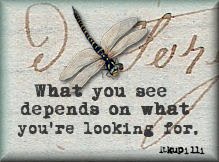I had a chance to talk to Norma from Stillwater Designs about her very beautiful Kachina collection. Her information was so informative that I thought I would share it with you. Keep in mind, I may have missed a few bits of information.....but I always recommend going to the different "Tribe" websites to get accurate information on their artwork, customs and their history. I just think that her adventures are so lovely and want to take a moment to share them with others who love and appreciate this intricate work and it's historical value.
This is a Hopi Kachina or Katsina. It measures about 1 inch tall. This Kachina was purchased in Winslow, Arizona. Kachinas are stylized religious icons, carved from cottonwood root, painted and sometimes decorated with feathers, to represent figures from Hopi mythology. They are spirits of the dead, intermediaries between man and the gods. Authentic Kachinas are made only by Hopi artists. The art of kachina carving is done by a few Hopi Indians, who dedicate their life to this art and it is handed from down generation to generation.
Above, Kachina figures are all Hopi. They measure from 1 inch to about 5 inches. They were all purchased in Winslow, Arizona. If you look at them closely, you'll see different animals represented, the one on the left, that is red and black with round eyes and mouth is called a mud man, the one toward the right with the white top with black strips is a clown. The detail is amazing on these ,considering the are not very tall. They are all carved from cottonwood root and they on a cottonwood base.
In the photo above, the 3 Kachina Dolls in the back are all Navajo. The Navajo ones are usually not as detailed as the Hopi. Notice the smaller ones in the forground are all Hopi and much more detailed.
He is a Hopi hoop dancer with rabbit fur, leather, shells and beads and was purchased in Cheyenne , Wyoming. He measures about 10inches tall.
Above: The one on the left is Hopi, he has rabbit fur and leather, and was purchased in Cheyenne, Wyoming. The one on the right is Navajo, with a rabbit fur collar, feathers and leather. The smaller ones in front are all Hopi, notice the detail.
Above is a "kachina" made by the Navajo. So according to the Hopi's it is a copy. I purchased this in Tucson, Arizona. He measures about 24 inches tall. He is surrounded by Turkey feathers and his arms are covered with rabbit fur and his clothing is made from leather. He is dancing on a cottonwood base. To give you an idea of the diffence in prices between a "real "Hopi kachina and a Navajo copy, I paid $25 for the 1inch Hopi kachina and $75 for the 24inch "copy."
The clay figures to the left of the basket are Storytellers, from the Navajo and Hopi (Arizona and Utah) tribes. In front of the basket are Indian fetishes made from different polished stones and turquoise. Each one has its own meaning. I think these are all Navajo. To the right of the basket are Kachinas made by two different Indian tribes. The two in the back are made by Hopi Indians and the two in the front are made by Navajo Indians.
These are all so beautiful! The next time you are in the southwest, make time to visit the galleries and/or visitor centers of the tribes to purchase their work and support the continuing education efforts of the different tribes.










